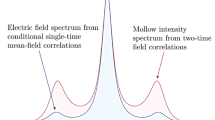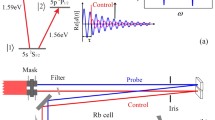Abstract
For a particular model with two electronic states, each with two vibrations, the dipole correlation function governing electronic absorption is e −iωOt cosγt with spectrum ω 0±γ. The function starts as e −iωOt (γ≪ω 0), with Fourier transform peaking around ω 0 instead of ω 0±γ, and this is associated with vertical excitation. After a time t∼2/γ the spectrum goes over into the normal one. As a generalization, a procedure is outlined for characterizing the state reached first after interaction with light is initiated. Finally it is suggested that one can understand aspects of internal conversion by analogy with the case of vertical excitation.
Zusammenfassung
Für ein Modell mit zwei Elektronenzuständen, jeder mit zwei Schwingungen, wird die elektronische Absorption durch die Dipolkorrelationsfunktion e −iωOtcosγt mit dem Spektrum ω 0±γ beschrieben. Die Funktion beginnt als e −iωOt (γ≪ω 0) mit dem Maximum der Fouriertransformierten um ω 0 statt ω 0±γ. Dies ist mit einer vertikalen Anregung verknüpft. Nach einer Zeit t∼2/γ geht das Spektrum in das normale Spektrum über. Als eine Verallgemeinerung wird eine Methode ausgeführt, die den Zustand der zuerst, nach einer Wechselwirkung mit Licht, erreicht wird, beschreibt. Es wird vorgeschlagen, daß bestimmte Aspekte der inneren Konversion durch Analogie zur vertikalen Anregung zu verstehen sind.
Résumé
La fonction de corrélation dipolaire gouvernant l'absorption électronique pour un modèle particulier à deux états électroniques, chacun avec deux vibrations, est e −iωOtcosγt avec le spectre ω 0±γ. La fonction commence comme e −iωOt(γ≪ω 0), avec une transformée de Fourier centrée autour de ω 0 au lieu de ω 0∓γ; ceci est associé à l'excitation verticale. Après un temps t∼2/γ le spectre devient normal. Description d'un procédé pour caractériser l'état premier atteint lorsque l'interaction avec la lumière est établie. Enfin on suggère que des aspects de la conversion interne peuvent être compris par analogie avec le cas de l'excitation verticale.
Similar content being viewed by others
References
Zimmermann,H., Scheibe,G.: Z. Elektrochem. 60, 566 (1956).
Anex,B.G., Simpson,W.T.: Rev. mod. Physics 32, 466 (1960).
Sponer,H., Teller,E.: Rev. mod. Physics 13, 75 (1941).
Simpson,W.T., Peterson,D. L.: J. chem. Physics 26, 588 (1957).
—: Theoret. chim. Acta (Berl.) 18, 354 (1970).
Rhodes,W., Chase,M.: Rev. mod. Physics 39, 348 (1967) and references therein.
Harris,R.A.: J. chem. Physics 39, 978 (1963).
Bixon,M., Jortner,J.: J. chem. Physics 48, 715 (1968).
Author information
Authors and Affiliations
Rights and permissions
About this article
Cite this article
Simpson, W.T. Vertical excitation as a transient phenomenon. Theoret. Chim. Acta 23, 295–308 (1972). https://doi.org/10.1007/BF00526435
Received:
Issue Date:
DOI: https://doi.org/10.1007/BF00526435




